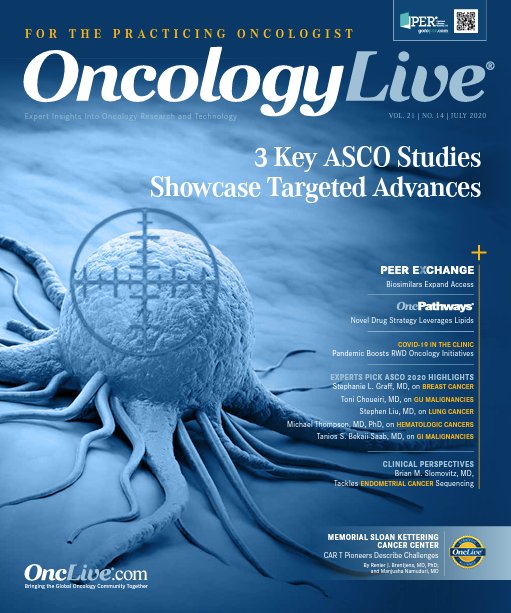UGN-102 Emerges As Potential Surgical Alternative for Low-Grade, Intermediate-Risk NMIBC
Primary chemoablation with UGN-102 elicited encouraging responses in patients with low-grade, intermediate-risk non–muscle-invasive bladder cancer and may consequently be an appropriate nonsurgical treatment intervention for patients.
William C. Huang, MD

Primary chemoablation with UGN-102 (mitomycin) elicited encouraging responses in patients with low-grade, intermediate-risk non–muscle-invasive bladder cancer (NMIBC) and may consequently be an appropriate nonsurgical treatment intervention for patients, according to interim results from the phase 2b OPTIMA II trial (NCT03558503) presented at the 2020 American Urological Association (AUA) Annual Meeting.1,2
Notably, 65% of patients achieved complete responses (CRs) just 3 months after initiating treatment with UGN-102.1 UGN-102 is a reverse thermogelation hydrogen that contains mitomycin. A standard urinary catheter delivers the gel formation into the body at a low temperature. Once it liquifies, the formulation warms to body temperature and becomes a gel for exposure to mitomycin for up to 6 hours in the bladder, investigator William C. Huang, MD, explained.
“These interim data demonstrate that primary chemoablation of low-grade, intermediate-risk non–muscle-invasive bladder cancer using UGN-102 results in a significant treatment response and encouraging durability,” said Huang, associate professor, Department of Urology at NYU Grossman School of Medicine, and chief, Urology Service, at NYU Langone’s Tisch Hospital in New York, New York. “The interim results from OPTIMA II indicate that UGN-102, if approved, may provide an effective, nonsurgical treatment option for these patients that is both well tolerated and durable.”2
Transurethral resection of the bladder (TURBT) and intravesical therapy are the standard of care for treating patients with low-grade, intermediate-risk NMIBC, which is defined by the presence of multiple and/or recurrent low-grade Ta tumors. The use of a single intravesical instillation of mitomycin C after TURBT was previously shown to reduce the risk of recurrence in patients with NMIBC.3
OPTIMA II was initiated to explore the efficacy and safety of UGN-102 for primary chemoablation in patients with low-grade, intermediate-risk NMIBC as a nonsurgical alternative to TURBT. The trial is an ongoing prospective, single-arm, open-label phase 2 study.
Intermediate risk was defined as disease with multiple tumors, a solitary tumor greater than 3 cm, and/or at least 1 occurrence within a year of diagnosis. Patients with negative voiding cytology for high-grade disease were also eligible to enroll. The trial excluded patients with a history of carcinoma in situ in the prior 5 years, high-grade papillary urothelial carcinoma (UC) within the prior 2 years, or bacillus Calmette-Guerin treatment for UC within the prior 2 years. Patients with prior or current muscle-invasive or metastatic UC or concurrent upper tract UC were also excluded.
A total of 63 patients were enrolled and treated with 6 once-weekly instillations of UGN-102. Patients were evaluated after 3 months for the primary end point of CR rate and followed for durability at the 6-, 9-, and 12-month visits. Safety was a secondary end point. The mean age of all patients was 70.5 years (range, 33-96), and men made up 60% of the population. Ninety-eight percent of patients had noninvasive papillary carcinoma, and 82% had multiple tumors.
As of the interim analysis, 36 patients were evaluable for response duration at 6 months, with 35 maintaining their response (97.2%; 95% CI, 85.5%-99.9%). At 9 months, 24 of 28 evaluable patients had an ongoing CR (85.7%; 95% CI, 67.3%-96.0%), and 11 of 13 evaluable patients (84.6%; 95% CI, 54.6%-98.1%) had durable CRs at 1 year.
Ninety-one percent of patients had at least 1 adverse event (AE), 64% had a study drug– or procedure–related treatment-emergent AE, and 6 patients (10%) discontinued treatment because of a treatment-emergent AE. One patient (1.6%) died as a result of an AE, and 5 patients (7.9%) had at least 1 serious AE.
The most common AEs observed with UGN-102 treatment were on the lower urinary tract, Huang said, and consisted of dysuria (41%), pollakiuria (19%), hematuria (14%), fatigue (13%), micturition urgency (13%), and urinary tract infection (11%).
UroGen Pharma, the developer of UGN-102, gained FDA approval in April 2020 for the use of mitomycin gel (UGN-101; Jelmyto) in low-grade upper tract urothelial cancer.

References
- Huang W, Chevli K, Trainer A, et al. Can TURBT be avoided? primary chemoablation with a reverse thermal gel containing mitomycin (UGN-102) in patients with low grade intermediate risk non-muscle invasive bladder cancer. J Urol. 2020;203(suppl 4):LBA02-03. doi:10.1097/JU.0000000000000958.03
- UroGen Pharma announces first presentation of data from phase 2b study of UGN-102 in patients with difficult to treat type of bladder cancer. News release. UroGen Pharma Ltd. May 15, 2020. Accessed June 15, 2020. https://bwnews.pr/2Z87qYm
- Bosschieter J, Nieuwenhuijzen JA, van Ginkel T, et al. Value of an immediate intravesical instillation of mitomycin C in patients with non-muscle-invasive bladder cancer: a prospective multicentre randomised study in 2243 patients. Eur Urol. 2018;73(2):226232. doi:10.1016/j.eururo.2017.06.038




